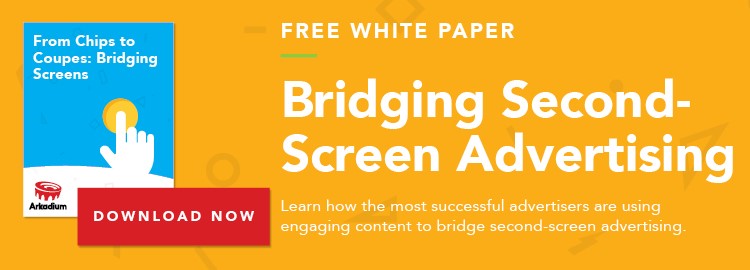What the Move Toward Visual and Interactive Means for Advertisers

According to a study conducted by advertising artificial intelligence company GumGum, two billion images are being shared online every day.1
To keep up with this trend and stand out, marketers have had to adapt their digital advertising strategies to include more visual and engaging advertisements.
In fact, 69 percent of marketers surveyed in the GumGum study said that they were spending over $100,000 per year to create visual content to support marketing objectives.2
Visual advertisements include elements of imagery and interactivity. They also focus on marketing to, and engaging with, consumers in space they are already actively viewing.3
Here is what advertisers are doing to establish successful visual advertising strategies.
Adapting Content
A recent study conducted by internet marketing service VIEO Design found that users consider every aspect of a web page – including ads – when rating its overall user experience.4
The report found that a whopping 83 percent of those surveyed would like the option to block intrusive and irrelevant ads from their browsing experience.5
In an interview with ExchangeWire, Greg Pritchard, SVP of business development at GumGum, spoke about how visual advertising can help with the current challenges marketers face, such as viewability and ad blocking.
“Advertisers are certainly savvy to the fact that consumers are very focused on images [and] publishers understand that they need to come up with a practical solution to generate engagement,” Pritchard said.6
“Consumers have short attention spans, so visual-centric content is a great way to get consumers to spend more time on site, as images are addictive,” he continued.7
According to MDG Advertising, content featuring compelling visuals averages 94 percent more total views than those without.8
What’s more, an increase in mobile internet usage has also prompted advertisers to adapt their marketing strategies to include more visual elements.
“There is so much information to process every minute, and we are generally processing this information on smaller screens, which inherently lends itself to consuming imagery – it’s much quicker to absorb what’s going on. Images make sense experientially where people are on their phones, on the go,” concluded Pritchard.9
However, visual advertising is not only about compelling imagery – it is quickly evolving into something more engaging and interactive.
Adopting New Practices
Recently, Josh Topolsky – co-founder of The Verge and Vox Media – created The Outline, a news site that integrates interactive ads between its articles and works with brand partners to create specific visual ads.
These ads include fact cards, draggable comparisons and games that readers can play on both mobile and desktop browsers.10
According to The Outline, ads on its site receive a click-through rate, on average, of 25 times the industry average.11 Additionally, the site sees around 13 times the industry average of engagement rates on its ads.12
So far, the news site has partnered with brands like Cadillac, Method and Under Armour.13
For the Cadillac partnership, The Outline created an interactive game titled Night Driver, which readers spent an average of 2.3 minutes playing.14
“The different executions they delivered to us was an embarrassment of riches,” said Riyhana Bey, director of brand execution and digital marketing for Cadillac.15
The Outline is not alone in its quest to serve users a more interactive and visual advertising experience.
Quick commercial: Arkadium’s newest product, InHabit, uses AI to deliver relevant interactive visualizations – called factives – to any article at scale, boosting user interaction.16 On average, users spend 40 seconds interacting with them, with some upwards of four minutes.17
The product integrates brand messages to active users in an intuitive, non-obtrusive manner.18
Indeed, as the digital mix becomes more visual and interactive, marketers will likely continue to adapt their strategies and take advantage of new opportunities.
1 Tanz, Ophir, and Ben Plomion. THE RISE OF THE VISUAL WEB. AND WHY IT’S CHANGING EVERYTHING (AGAIN) FOR MARKETERS. N.p.: GumGum & Brand Innovators, 2017. PDF.
2 IBID
3 “What Does the Rise of the Visual Web Mean for Traditional Ad Formats?” ExchangeWirecom. N.p., n.d. Web. 01 Aug. 2017.
4 “New Data on Why People Hate Ads: Too Many, Too Intrusive, Too Creepy.” VIEO Design. N.p., 12 Sept. 2016. Web. 09 Aug. 2017.
5 IBID
6 “What Does the Rise of the Visual Web Mean for Traditional Ad Formats?” ExchangeWirecom. N.p., n.d. Web. 01 Aug. 2017.
7 IBID
8 “It’s All About the Images [Infographic].” MDG Advertising | Marketing News and Trends. N.p., n.d. Web. 08 Aug. 2017.
9 “What Does the Rise of the Visual Web Mean for Traditional Ad Formats?” ExchangeWirecom. N.p., n.d. Web. 01 Aug. 2017.
10 Main, Sami. “The Outline Is Making Visual, Interactive Content and Ads for a ‘Post-Text’ Internet.” Adweek. Adweek, 28 Feb. 2017. Web. 26 July 2017.
11 IBID
12 IBID
13 IBID
14 IBID
15 IBID
16 “Interactive Data Visualization at Scale.” InHabit. Arkadium, n.d. Web. 07 Aug. 2017.
17 IBID
18 IBID


